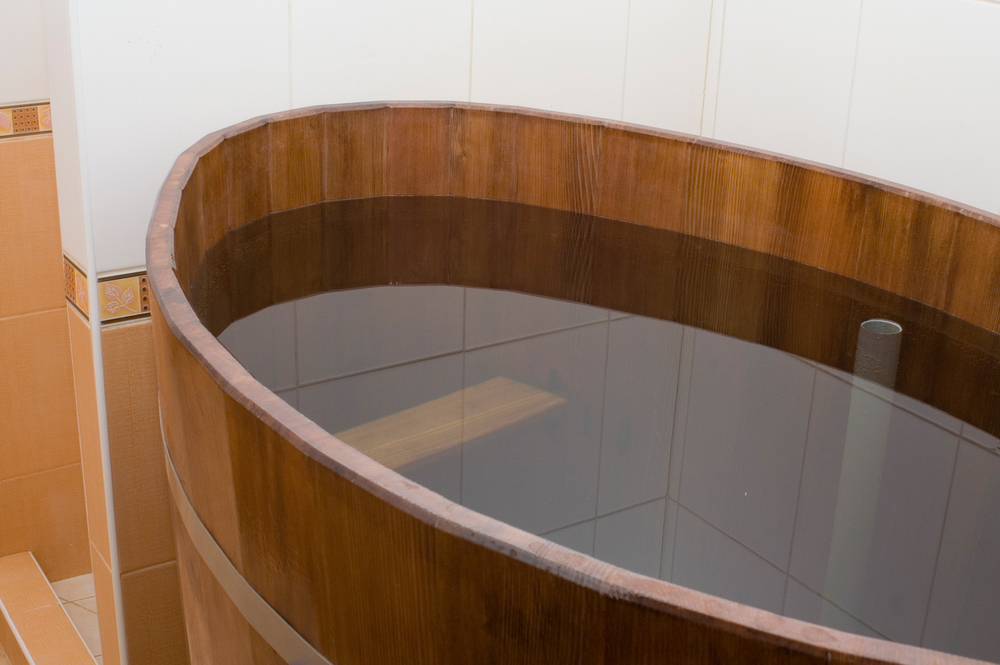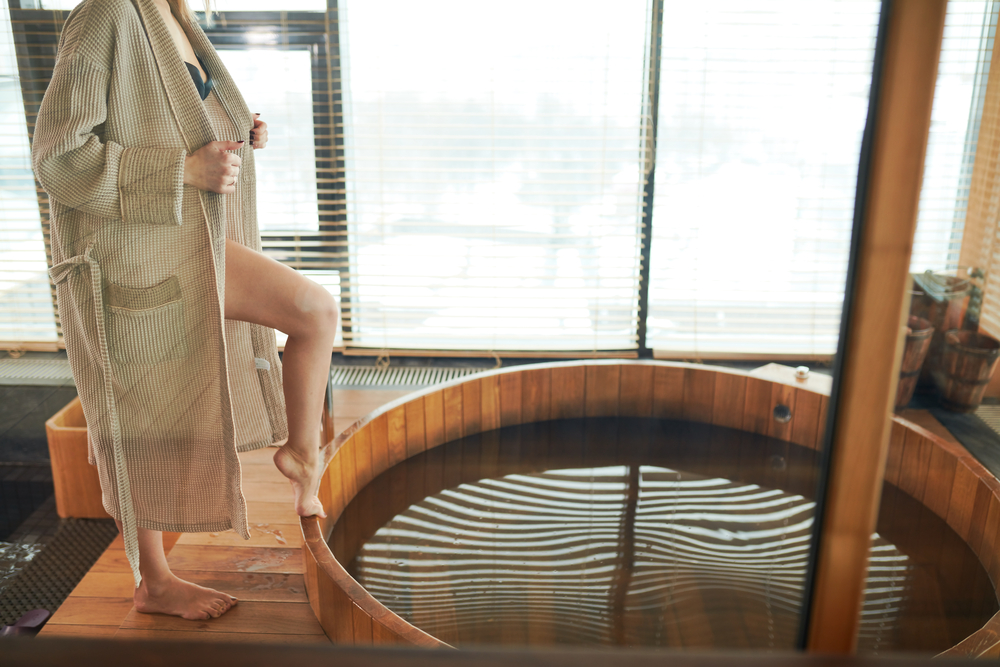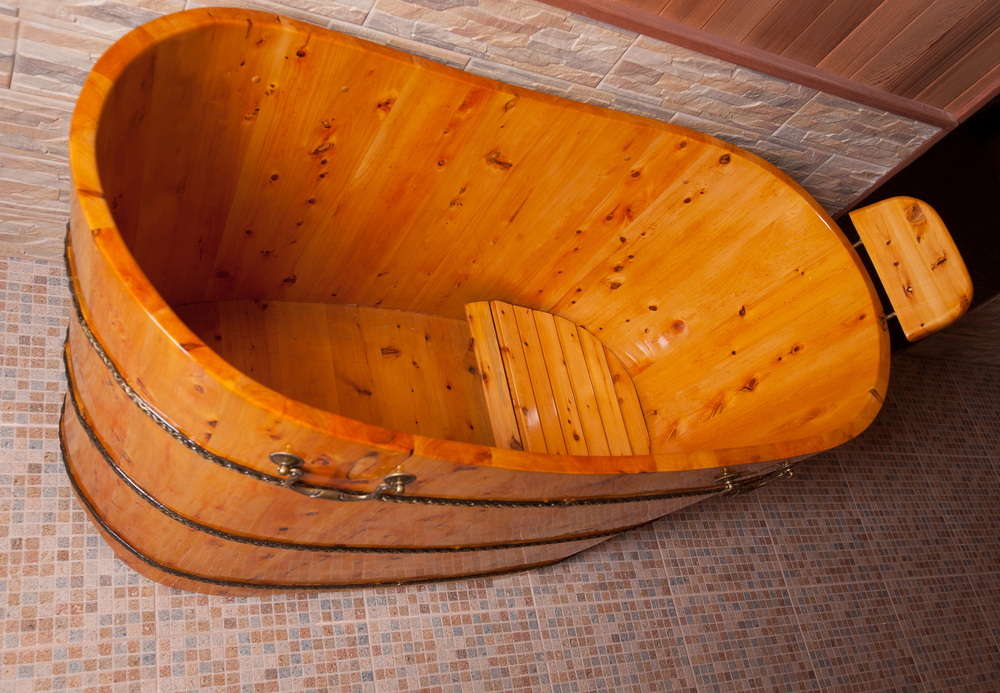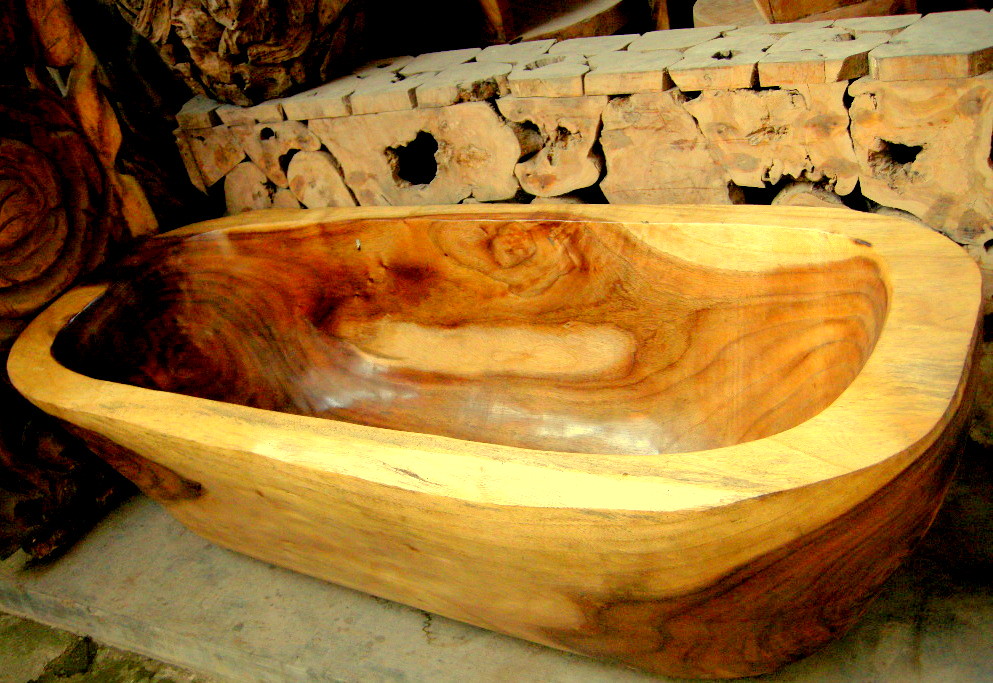Wooden bathtubs require planning, precise construction, and maintenance. However, they are an elegant and unique addition to your bathroom.
Guide to Set Started
Materials Needed:
- Wood: Choose a durable wood species like cedar, teak, or redwood that can withstand water exposure.
- Waterproof Sealant: Use a waterproof sealant suitable for wood to protect it from moisture damage.
- Tools: You’ll need a saw, drill, sander, and measuring tape.
- Fasteners: Screws or nails, depending on your design.
Steps
- Design Planning: Sketch your bathtub design, considering dimensions, shape, and features.
- Wood Selection: Choose high-quality wood that’s suitable for wet environments. Cedar is popular due to its natural resistance to decay and insects.
- Cutting the Wood: Use a saw to cut the wood to the desired dimensions. Be precise to ensure the pieces fit together properly.
- Assembly: Assemble the pieces according to your design, using screws or nails to secure them together. Pay attention to sealing gaps to prevent water leakage.
- Sand and Smooth: Thoroughly sand the bathtub to remove rough edges and splinters. This step is crucial for comfort and safety.
- Sealing: Apply multiple coats of waterproof sealant to all bathtub surfaces. Follow the manufacturer’s instructions for application and drying times.
- Test Run: Before using the bathtub, fill it with water and let it sit to check for leaks. Make any necessary repairs or adjustments.
Tips
- Safety First: Use appropriate safety gear, such as goggles and gloves, when working with tools and chemicals.
- Proper Ventilation: Ensure good ventilation when applying sealant to avoid inhaling fumes.
- Maintenance: Regularly maintain your wooden bathtub by reapplying sealant as needed and cleaning it with mild soap and water.
- Considerations: Wood expands and contracts with changes in temperature and humidity. To prevent cracking or warping, design your bathtub with this in mind.
Some inroads are being made into this sanctum space as woodworkers find good ways of waterproofing their projects. We see this mainly in the luxury bathroom sinks and vanity countertops, where natural-edge wood slabs find their way into fancier homes. But a wood bathtub is the ultimate luxury of putting a touch of wood into your bathroom.
Cost of Wooden Bathtubs
Wood bathtubs can run for upwards of $30,000, making them some of the most expensive wooden or copper bathtubs on the market. You can spend more buying something carved out of solid crystal or marble.

Kinds of Wood Baths
To clarify, there are three different things that you can refer to as “wooden bathtubs:”
- A Japanese-style deep wood hot tub
- A freestanding bathtub made of wood (essentially a modification of the Japanese hot tub, in the shape of an old-fashioned freestanding bath)
- A laminated hardwood tub
The other two bathtubs are cheaper compared to the laminated hardwood tub. You can buy them for a few thousand dollars or even find them for sale at your local building materials center. These are “natural wood” tubs made out of wood that can withstand decay (cedar, walnut, or rubber wood) caused by water. Only one company makes laminated hardwood tubs, NK Woodworking and Design.

All types and sizes of tubs are installed in your bathroom, just like any other shower or freestanding tub would be installed. All you have to do is set the tub in place, then connect the faucets and drain. It’s easier than installing a built-in tub.
Steps on How to Make a Wooden Bathtubs
To start with, you’ll need a framework. Any boat I’ve ever seen built starts with a framework. In this case, the framework won’t become part of the finished tub but will help in the layup and gluing of the tub. To work, the inside contour of the finished tub needs to be followed, keeping in mind that the final dimensions of the inside of your tub will be slightly larger than the framework’s dimensions. Once laid up and glued, the final contour will be created by planning and sanding the tub’s interior and exterior.
I would recommend waxing the outside of your framework so that the glue from laminating the layers of your tub together can’t stick to it. It would be possible to break the framework and then clean up any scrap from the inside of the shower tub, but waxing the framework will eliminate the hassle of doing this, saving you time.
Assemble the base first, shaping and gluing the pieces together and setting them on your gluing bench. I’d recommend using some template or jig to hold them in place to ensure they don’t move as you add additional layers.
The following piece is the floor of your tub. This is flat, assembled by joining ¾” planks, much like making a tabletop. I would recommend using dowels or biscuits when assembling this for added strength. Once laminated, please attach it to the base, ensuring it is properly centered.
With the tub floor attached to the base, the easy part of the project is completed. It is now time to start laminating the sides. If your tub has tapered sides, each layer must be cut differently. Each layer will be slightly larger than the one below. The layers are cut oversized, with extra material to the outside and the inside (which sits up against your framework to give you a good reference for shaping the tub), leaving that material for final shaping.

Traditional wood bath, inside shot
As with boat building or laying a hardwood floor, the joints must be staggered from one layer to another. Even so, making the long sides with fewer joints will be easier, as they won’t be necessary. More joints will be needed at the ends due to the curvature running out of the sides of the boards.
It would be helpful to make cardboard patterns for each layer as you go to avoid wasting material. The pattern can be taken off the layer below and suitably modified to keep it in contact with the framework at all points. Depending on the complexity of your tub’s overall design, curves designed and cut out of thin plywood can be used as patterns for the corners, as the corner’s curvature will stay consistent in some designs.
Two layers of planking can be laminated and cut out on the band saw to make the needed size. It will be necessary to verify that the four to six pieces that make up a layer fit snugly together, without any gaps, before installing them to create the tub.
Clamping the tub as you build it up is another challenge to overcome. The secret here is to use bridges over the top of the added layer, with bar clamps going from there to create the bottom side of the bathtub benchtop. You may need some help clamping to tighten both sides of the bridge simultaneously.
Keep each layer clamped until the glue has a chance to dry. Make this a prolonged project to complete, as it will take longer for the glue to dry than to cut the next layer of parts to install.
Luxury Bathtub
Most luxury bathtubs are built with a slight taper and rounded ends, bottoms, and corners. However, this isn’t an absolute requirement, as there are modern tub styles that are squared off. NK Woodworking and Designs even have them.
Shaping the Wooden Bathtubs
With the glue-up of the whole bathtub tub completed, the final shaping must be accomplished. You will need to carve the final form of the tub from the rough glue-up you have made. Layers must be blended into each other, as the overall thickness of the tub’s sides is brought down to roughly an inch.
Ensure you drill the appropriate holes for the faucets and drain before you get too far along in the bath and shaping process. If you wait until you have the bathtub shaped, you may end up with chips from a hole saw to deal with. You’re better off doing that earlier in the week during the shaping process to smooth the edges of those holes as you shape and sand the bathtub.
Several different tools can be used for this shaping process, depending on what you have available in your workshop. Some possibilities include:
- A chainsaw cutting wheel mounted to an angle grinder
- A spokeshave (a bit small, but possible)
- Wood planes (there are planes with curved soles, which could be used for the inside of the tub)
- Mallet and chisels
Once the final shape is completed, the tub must be sanded. Starting with coarse-grade paper and gradually moving to finer and finer grades.

Wood bathtub, Indo Gemstone
Finishing the Wooden Bathtubs
A proper finish must be applied to the tub to protect the wood from water damage. We can take a page from the playbook of those who make the stunning luxury, natural-edge wood slab countertops. They use a thick epoxy coating for their finish because it is waterproof and durable. It is possible to tint the epoxy. It is done with “river” maple countertops, but to enjoy and display its full natural beauty and warmth.
Since you will be working without a mold, you’re better off with a heavy-bodied epoxy with a high viscosity than a thinner epoxy, leaving you with runs in your finish. The heavier-bodied the epoxy is, the faster it will build up a finish. But if you are not careful, it will also make hiding runs more extensive and complicated.
Having worked with this sort of epoxy on a curved surface like this before, I can tell you that the trick is figuring out how thick a coat you can apply without the coat starting to sag and run. You’ll need to keep track of the product all the time. You don’t want to use the epoxy once it starts to set up, as the gel-like consistency will tend to leave lumps in your finish.
Use an epoxy with a short set time so it doesn’t have much time to run. But this will require that you mix your epoxy in small batches, no more than you can work with, in the space you have before it begins to gel. Don’t worry. You can always mix more.
To Avoid the Damages
Special care should be taken to ensure the finish isn’t damaged when moving or installing items in the tub. Even the smallest dents could have dire consequences for the quality and longevity of your tub, causing the finish to fail long before it should.
You will want to monitor the finish, ensuring it doesn’t become damaged and the wood doesn’t become exposed. Adding coats of finish over the existing finish is much easier if you can do it before the existing finish or the substrate it is on is damaged.



